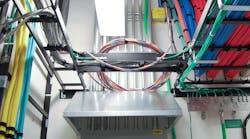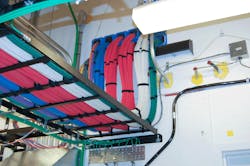Sixteen years after its initial IEEE standard was published, Power over Ethernet (PoE) remains one of the hottest technologies around. PoE chipset sales will have a compound annual growth rate of 12.6% through 2025 — when sales will top $1.2 billion, Grand View Research predicts.
A lot of that growth will be spurred by IEEE 802.3bt, published in September 2018, that supports up to 90W. The additional power will enable PoE to support an even wider range of devices and applications — including ones that traditionally required an AC outlet. One potential example is electronic door locks used in hotels, schools, and other commercial buildings. The extra power could run the motor that pulls back the striker.
“I’d love to see it take off in the access control market,” says Dave D’Ettorre, RCDD, project manager for O’Connell Electric’s communications division. “We’re home-running four cables generally back to a closet to a power supply to power that striker and to the access control panel for the card reader. If that could be done over one Cat. 6 to any network point, it would be a big deal in saving a lot of cabling and a lot of cost for the end-user.”
The higher power also will help PoE keep up with trends in applications that it already serves. One example is Wi-Fi access points.
“We have an increased number of bands and higher speeds that require higher power,” says Sameh Boujelbene, senior director, campus network, data center and Ethernet switch, at the research firm Dell’Oro Group.
Ditto for their cellular counterparts, known as distributed antenna systems (DAS) and small cells. Most mobile operators are now rolling out fifth-generation (5G) networks, which use dozens more bands than 4G, as well as highly sophisticated antenna systems to deliver gigabit speeds. All those capabilities require more processing power and thus electrical power.
“For security integrators, maybe they start thinking there’s going to be a ton of small cell networks to deploy,” says Ray Coulombe, managing director of SecuritySpecifiers, a consultancy network. “Maybe that’s a business opportunity they should be looking at.”
Some contractors already are.
“I’m running into more and more DAS applications,” says David Schrembeck, whose company, DBS Communications, specializes in low-voltage applications such as video surveillance and phone systems. “To get involved with those and do them right is huge bucks.”
The higher power of 802.3bt also is a good fit for surveillance cameras with motors to enable pan-tilt-zoom functionality, as well as those with heaters and blowers for frigid or humid installations. Surveillance cameras also increasingly include onboard analytics to recognize faces and detect events such as dropped bags, and then determine whether it’s worth feeding that video back to a security operations center. As that artificial intelligence becomes even more sophisticated, it could eventually require more power.
“If you look at IP phones, even though they are declining, the new devices are adding telepresence features,” Boujelbene says. “So, you have new features on traditional PoE devices that will drive demand for higher power. We also have new PoE devices and applications that are driving new requirements in terms of power, such as network-attached storage, building automation and lighting, industrial controls and sensors, [and] access controls.”
Meanwhile, some devices are drawing less power than previous generations. For example, as digital signage and other displays migrate to more energy-efficient technologies, PoE can support bigger screen sizes than in the past. With the addition of 802.3bt, even less displays will require their own outlet.
Out With the Old? Not So Fast
The current selection of 802.3bt products is slim. As it increases, so does the age of existing PoE installations. Some of that gear will need to be replaced with 802.3bt equipment.
“For power devices (PDs), we expect 802.3bt products to be additive rather than replacement of legacy products,” Boujelbene says. “But for the PoE switches, we expect to see more replacement of legacy switches due to aging, combined with adding new 802.3bt switches. From our interviews with vendors and end-users, we expect 30% replacement and 70% new.”
Many legacy cables also will need to be replaced — good news for contractors specializing in pulling PoE lines.
“Our industry can’t just assume that you can take an old Cat. 5 cable or a bundle of Cat. 5 cables and repurpose them for the next generation of PoE without thinking through elements such as heat, distance [and so on],” says Chuck Wilson, executive director of the National Systems Contractors Association, whose members specialize in low-voltage systems.
Isn’t it 100W?
Although 802.3bt often is referred to as “100W PoE,” that’s not the case.
“The standard is written to only guarantee 90W at a power source equipment (PSE) port,” says Chad Jones, an Ethernet Alliance member and chair of the IEEE P802.3bt task force. “Therefore, this is 90W PoE, known as Class 8 in IEEE 802.3bt.”
This 10W difference also affects how 802.3bt fits with the National Electrical Code (see Table 1).
“Cable bundling was added to Art. 725 in NEC-2017,” Jones says. “Table 725.144 translates conductor current into allowed bundle sizes based on the AWG of the cable. The minimum port voltage for a 90W PSE is 52V. This translates to 0.433A per conductor, and this is the current you’d look up in the table.
“But Table 725.144 is for ampacities with the cable at 30°C ambient. The IEEE 802.3bt PoE standard is based on TIA TSB-184A guidelines, which assume a more restrictive 45°C ambient temperature.”
“Reading into the table, you will see the ‘no-brainer’ choice for new installs that will support the highest class of PoE is to use cable composed of 23AWG conductors and rated at 75°C,” Jones says. “This will allow bundles of 192, which when talking about delivering 90W per cable, is a very large bundle.”
Cat. 6a should cover those requirements, but it’s still worth double-checking.
“If you are sure the bundles will be smaller than 91 cables, then a 24 AWG, 75°C cable will suffice,” Jones says. “Cat. 5e cables generally satisfy those requirements, but again, the installer should confirm.”
Some of the 100W misconceptions are due to vendor marketing claims that round up for the wow factor. Others are the product of miscalculations.
“The bulk of the misconceptions come from computing the current in a PoE system from the power,” Jones says. “Frequently, assumptions about the supply voltage or the cable resistance lead to the wrong answers.”
The upshot is that 802.3bt could mean more business for electrical contractors that pull category cable for other firms, such as audio-video integrators and security providers. But don’t expect that business to flood in anytime soon. One reason is because vendors are still developing what’s known as type 4 power devices, which are the models capable of supporting the Class 7 and 8 power levels (see Table 2).
“They don’t exist yet,” Jones says. “The market is just beginning to roll out solutions that take advantage of the advancement offered by IEEE 802.3bt.”
Avoiding Plug and Pray
IEEE developed 802.3bt because there was demand for higher power PoE. In fact, there’s been so much demand for so long that some vendors decided they couldn’t wait for a new IEEE standard. That led to the non-standard version known as PoE++.
“It took many years for the standard to be finally released, resulting in some companies building non-PoE standard products to cover the use cases that need more than 25.5W,” Boujelbene says. “But I expect those products to be short lived and to be replaced by standard-based products.”
Interoperability is something to consider when the client wants to expand an existing PoE system or when it’s a multivendor environment. IEEE 802.3bt is designed to be backward-compatible with 802.3af and 802.3at products, but there is no guarantee that it will support PoE++ devices because that’s a proprietary technology.
“The one caveat is when an older PSE restricted to a lower power class is connected to a newer, higher power Class PD, [such as an] IEEE 802.3af PSE Class 3 connected to an IEEE 802.3bt PD Class 6,” says David Tremblay, chair of the Ethernet Alliance’s PoE subcommittee. “This PD will receive power but will be ‘power demoted.’”
This demotion is facilitated by mutual identification, a process in the PoE standards where PSEs and PDs learn what their powering partner supports. So, if the PD knows it has only 13W available, it will start disabling features to ensure it doesn’t draw more than that amount.
“This might be one of the most confusing aspects of the new IEEE 802.3bt standard,” Tremblay says.
That’s why the Ethernet Alliance PoE Certification Program includes PSE and PD logo marks, which vendors put on products and in documentation. These help system designers and installers quickly identify power levels.
“One simply needs to see that the Ethernet Alliance Certified PSE logo number is greater than or equal to the Ethernet Alliance Certified PD logo number to know that the PD will not be power demoted,” Tremblay says.
The Ethernet Alliance’s FAQ at http://ethernetalliance.org/wp-content/uploads/2017/05/PoE-FAQ.pdf provides an overview of why the certification program was created and what it includes. Expect an update at some point.
“A lot has changed since [the FAQ published] in May 2017, but not much of it is externally visible yet,” Tremblay says. “The certification program now has 39 products listed on its products registry. In addition, several of the contributors to the IEEE 802.3bt standard are also working on a Generation 2 (Gen 2) Ethernet Alliance Certification Program test plan. The Gen 2 Ethernet Alliance Certification Program is expected to launch in fourth quarter of 2019.”
Safety First
With higher power comes questions about whether there’s greater risk of arcing at connectors, or overheating bundles.
“Manufacturers have done a significant amount of testing at that higher wattage to make sure that even in a tightly bundled cabling configuration, there’s no risk of excessive heat,” says NSCA’s Wilson. “It’s just a matter of the conductor size, the spacing of the conductors, and the proper category cable for that application.”
“It is very hard to install it in an unsafe manner,” Jones adds. “The ports themselves are Class 2 power-limited circuits as defined in Art. 725.”
The 2017 NEC defines a Class 2 circuit as “the portion of the wiring system between the load side of a Class 2 power source and the connected equipment. Due to its power limitations, a Class 2 circuit considers safety from a fire initiation standpoint and provides acceptable protection from electric shock.”
“The addition in 2017 was purely about cable bundling to ensure that cables couldn’t overheat,” Jones says. “This was a speculative addition to the NEC as there has been no record of loss from a PoE system in an installed base of nearly one billion ports.”
PoE devices typically are unplugged only when they’re decommissioned. That’s one reason why arcing shouldn’t be a problem even with 802.3bt’s higher power.
“A PoE system uses something called detection to determine that a PD that requires power is present before power is applied, meaning there is zero arcing on mating. None,” Jones says. “There will be arcing on unmating, and the RJ45 connectors have been engineered such that the arcing will happen in an area that is different from the contact area when full seated. This ensures that any pitting that may happen will not interfere with communications or power transfer.”
Kridel is an independent analyst and freelance writer with experience in covering technology, telecommunications, and more. He can be reached at [email protected].
Sidebar: 802.3bt – Four Pair Power over Ethernet
After being on the horizon for several years, the standard for four pair Power over Ethernet (802.3bt) was adopted last summer, and 2019 will see the wide availability of these high-powered sources and devices. The new “bt” standard switches will be able to source up to 90W of power over four pairs of twisted pair cabling. This allows designers to avoid the cost of installing outlets for power-hungry devices such as lighting, network-attached storage and large flat-panel displays.
As shown in the illustration, the plethora of power levels and names offers an opportunity for confusion and difficulties with interoperability. Thankfully, the Ethernet Alliance has stepped in to reduce the confusion with a simplified certification program for power sourcing equipment (PSE) and powered devices (PD). This program labels PSEs with their available power class and PDs with their required class of power, meaning designers and installers need only make sure that the PSE’s class is greater than or equal to the PD’s.








